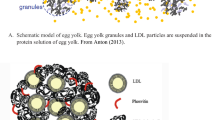Abstract
THE presence of a relatively large quantity of mineral material, mainly calcium carbonate, in the egg-shell (exochorion) of Phasmidæ has been established by Pantel1 (in eggs of Donusa prolixa). Extending his examinations to the egg content, Pantel found that the Malpighian tubules of fully developed embryos contained calcium salts far in excess of the quantity which he was able to demonstrate in the yolk of freshly laid eggs. Pantel interpreted this finding by assuming that most of the calcium in the yolk was organically bound and therefore not responsive to his methods of detection.
Similar content being viewed by others
References
Pantel, J., C.R. Acad. Sci., Paris, 168, 127 (1919).
Needham, J., "Chemical Embryology", 3, 1280 (1931).
Plimmer, R. H. A., and Lowndes, J., Biochem. J., 18, 1163 (1924).
Karashima, J., Jap. J. Biochem., 10, 275 (1929).
Author information
Authors and Affiliations
Rights and permissions
About this article
Cite this article
MOSCONA, A. Utilization of Mineral Constituents of the Egg-shell by the Developing Embryo of the Stick Insect. Nature 162, 62–63 (1948). https://doi.org/10.1038/162062a0
Issue Date:
DOI: https://doi.org/10.1038/162062a0
- Springer Nature Limited
This article is cited by
-
From Entomological Research to Culturing Tissues: Aron Moscona’s Investigative Pathway
Journal of the History of Biology (2021)
-
Embryonic use of egg shell calcium in a gastropod
Nature (1975)





